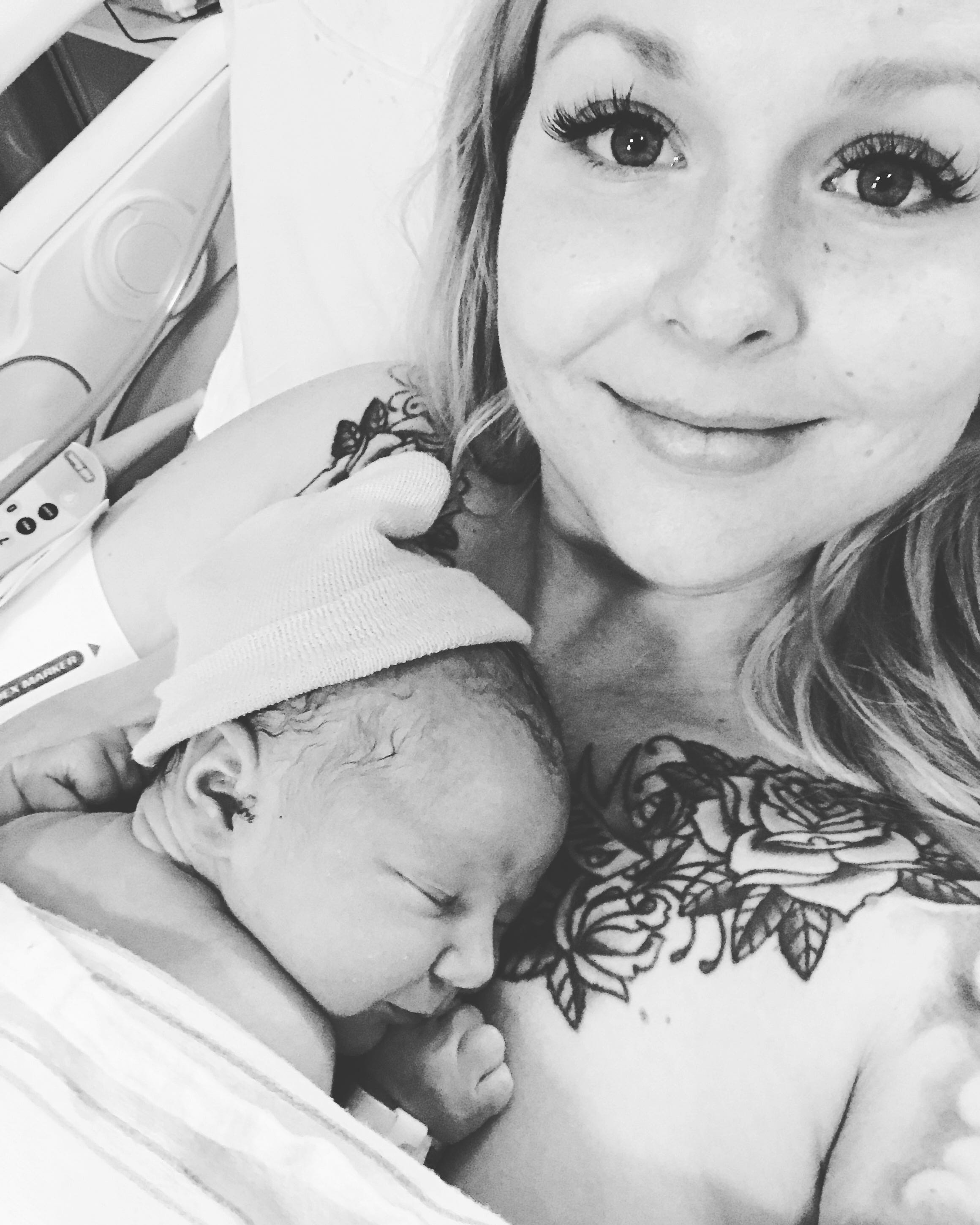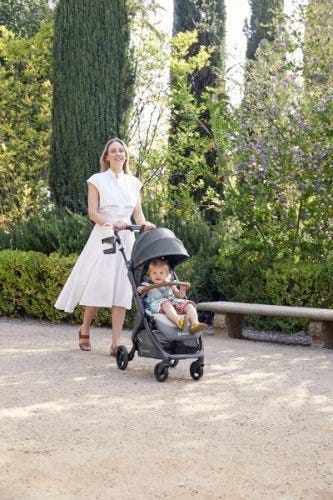
Once she’s born, your baby first learns about scent, touch, sight, hearing, taste and trust —along with many other things—from being right there against you. She came from you. And now that she’s here, skin to skin, also known as Kangaroo Care, is a way to maintain that unique closeness you and baby shared when she was in your womb. When naked baby is put right onto mom’s bare chest, skin to skin, she is usually happier. Remember in the womb, your baby didn’t have to regulate her temperature. So right there next to you helps her stay nice and cozy. In my experience, babies who are allowed more time skin to skin have better weight gain than those who are not. They literally have access to mom’s breast milk whenever they want it. They also don’t have to use their calories to regulate their own temperatures — they use their energy to grow. This means a happier infant with a stable heart and breathing rate. When a mother practices skin to skin, her own stress levels are reduced, which can significantly combat post-partum depression. Regularly practicing the closeness only helps you bond with your child, as well as can help you speed up your own labor recovery. With regulated hormones, your levels of maternal oxytocin will increase and that is very good news for your milk supply. The interest in skin-to-skin contact can be traced back to the late 1970s when doctors in Bogatá, Columbia ran out of incubators to keep the hospital newborns warm so instead they put the tiny babies right on bare chests to keep them warm. The babies thrived and people began to take notice. Here are few tips I like to suggest to promote skin-to-skin for new mothers:
Plan on skin to skin in the hospital.
If everything is safe and the baby is okay, have it in your birth plan for the doctors to put the baby skin to skin. A newborn held skin to skin immediately after birth is much more likely to breastfeed within the first hour than a swaddled newborn.
Create a private sanctuary.
When you’re in the hospital room, you can pull the curtains around your bed to get some privacy. I suggest to bring your own cozy blanket, nursing pillow, or robe from home to help cover you up and wrap around you and your newborn.
Keep bare contact going at home!
When you get home, spend as much time as possible skin to skin. In bed, it’s nice to recline on a pillow with baby on your chest. Bathing with baby on your skin is also replenishing and may help with latching with breastfeeding.
Carriers help!
Try a wrap or baby carrier, such as the Ergobaby Omni 360 baby carrier to hold your diaper-only baby against your bare chest, then put a button-front shirt over both of you. Skin-to-skin time with your partner is also very valuable. Skin to skin time helps partners to feel empowered. Partners are able to read hunger cues, calm baby, and reduce stress. Time with partners allow moms a chance to get some sleep. Remember, placing baby skin to skin gives her unlimited access to the breast and encourages breastfeeding. It can help to solve breastfeeding problems, prevent hypoglycemia and other newborn challenges, reduce pain, stabilize premature infants and encourage your baby’s brain development. Photo courtesy of Dani Hampton.
Emotional Benefits of Getting Outside
Spending time in nature with your baby can strengthen the bond between you. The simple act of holding your baby close, feeling their warmth, and sharing new experiences together can create strong emotional connections. It’s also a wonderful way to reduce stress and improve your mood. When my littles were extra fussy, I’d take a walk around the neighborhood. Even though I don't live in an area with trails and surrounded by nature, simply behind outside changed everything. A little vitamin D does wonders!
Cognitive Development
Nature is a sensory wonderland for babies. The different sights, sounds, and smells can stimulate your baby’s senses and promote cognitive development. Watching leaves rustle, hearing birds chirp, and feeling the texture of a tree bark can all contribute to their learning and development.
All About Baby Carriers for Nature Adventures
Choosing the Right Baby Carrier
When it comes to selecting the best baby carrier for summer adventures, there are several options to consider.
Types of Baby Carriers:
- Wraps: Perfect for newborns, providing a snug and secure fit.
- Slings: Ideal for quick and easy use, offering good ventilation.
- Soft Structured Carriers: Versatile and comfortable for both parent and baby, suitable for longer trips.
Factors to Consider:
- Baby’s Age and Weight: Ensure the carrier is appropriate for your baby’s size and weight. For example, Ergobaby’s Embrace Newborn Carrier is perfect for the fourth trimester where baby is small and you’re looking for an easy way to stay close. As they grow, you’ll want to upgrade to an all-position carrier that’s meant for growing babies.
- Parent’s Comfort and Ergonomics: Look for carriers with padded shoulder straps and lumbar support if you’re planning on longer outings.
- Ease of Use: Choose a carrier that is easy to put on and take off.
- Climate and Breathability: Opt for carriers made of breathable fabrics to keep you and your baby cool in hot weather.
Safety Tips:
- Proper Positioning: Ensure your baby is seated correctly, with their legs in an "M" position and their head should be close enough to kiss.
- Checking for Wear and Tear: Regularly inspect your carrier for any signs of damage.
- Ensuring Adequate Support: Make sure the carrier provides proper support for your baby’s head and neck.
Exploring Nature with a Baby Carrier
Ideal Spots for a Nature Walk with Baby
- Parks and Gardens: Great for leisurely walks and picnics.
- Nature Trails and Forests: Perfect for more adventurous outings.
- Beaches and Lakesides: Wonderful for enjoying the water and sand, with the right carrier.
Activity Ideas
- Hiking: Enjoy a scenic hike with a hiking baby carrier that offers support and storage.
- Bird Watching: Use your carrier to keep your baby close while you explore and observe wildlife.
- Picnics: A carrier can free up your hands, making it easier to carry picnic supplies.


Advantages of Using Strollers for Nature Adventures


While baby carriers are fantastic for mobility and closeness, depending on the adventure of choice you might want to be a stroller along too.
There are a LOT of baby stroller options on the market. So we understand how confusing it can be to choose the one that’s right for your family. Not only are there a variety of brands, but a variety of strollers that serve different purposes.
There are a few types of strollers on the market:
- Full-sized stroller: This is typically the stroller parents thing of buying for all its versatility.
- Lightweight or umbrella stroller:These compact strollers are perfect for on-the-go adventures.
- Jogging stroller: Designed for parents who want to combine fitness with outdoor adventures.
- Double stroller: Designed for parents with multiple kids, especially twins.
- Car seat carrier: These strollers connect to a specific car seat. We don't typically recommend these as they can be unsafe for baby and uncomfortable for parents who are pushing.
Learn more about the types of strollers and which one would be best for you.
Benefits of Bringing a Stroller
- Storage Space for Gear: Ample room for carrying all your essentials like a diaper bag, beach toys and more.
- Shade and Weather Protection: Built-in canopies to shield your baby from the sun when they are lounging.
- Options: If you have more than one kid, you can stroll with one and carry the other. Or, if you’re getting warm or your little one is getting fussy, you can switch up their position from stroller to carrier or vice versa.
Safety Tips for Strollers
- Ensure your stroller is in good working condition. Make sure buckles are still buckling and that there are no rips or holes that could compromise your baby’s safety.
- Use sunshades or bug nets to protect your little one’s skin.
- Securing the baby properly: always buckle up your baby for safety even if you think they are old enough to go without the buckle.
Combining Baby Carriers and Strollers
For the ultimate flexibility, consider using both a baby carrier and a stroller on your outings.
Combining both options allows you to adapt to different situations. Use the carrier for more rugged trails and switch to the stroller for smoother paths or when your baby needs a nap.
Transition Tips
- Smooth Transitions: Plan stops where you can easily switch from carrier to stroller.
- Pack Light: Only bring essentials to make transitions easier.
Tips for a Successful Adventure
Planning Ahead
- Route Planning: Choose baby-friendly trails and parks. Check local mom groups or outdoor groups and get recommendations for the best outings for kids.
- Check Weather Conditions: Avoid extreme heat or unpredictable weather. Even with our most breathable carriers, when it’s hot, it’s hot. And having two bodies against each other in the heat will be naturally hot and sticky already.
- Packing Checklist: Include diapers, snacks, water, sunscreen, and a first-aid kit. These all-position carriers have storage pockets where you can fit some of the items easily!
- Stay Hydrated and Nourished: Pack healthy snacks to keep energy levels up and bring plenty of water for both you and baby.


Summer adventures with your baby are a wonderful way to create lasting memories and enjoy the beauty of nature together. From baby carriers to strollers, Ergobaby products are designed to provide comfort and ease for both you and your little one. So, gear up, get outside, and explore the world with your baby by your side.
Ready to embark on your own summer adventures? Check out Ergobaby’s range of baby carriers and strollers to find the perfect match for your family’s needs. Visit our website today and start planning your next outdoor excursion!





























